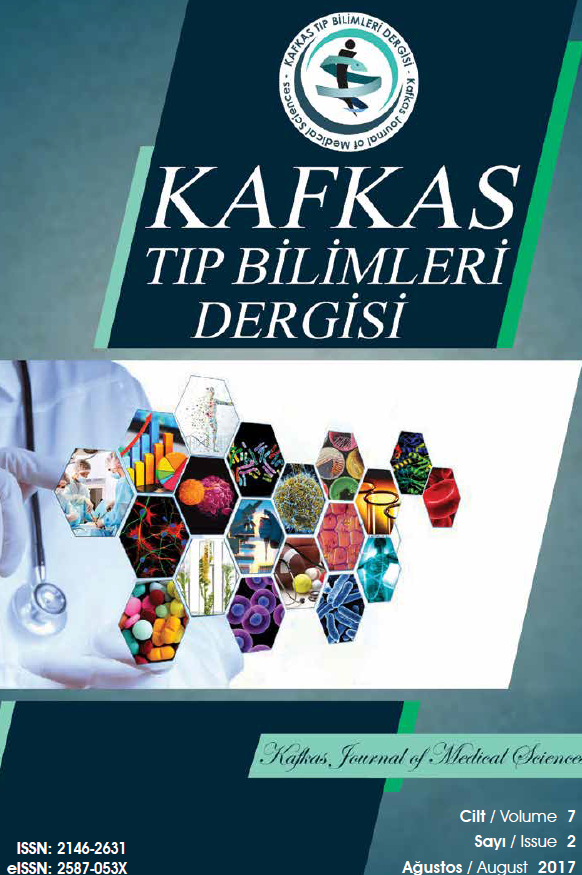Koroner Arter Bypass Grefti Cerrahisine Giden Diyabetik Hastalarda Preoperatif Sigara Kullanılmasının Postoperatif Serebrovasküler Olaylar Üzerine Etkisi
AMAÇ: Bu çalıșma koroner arter bypass cerrahisi (KABC) uygulanan diyabetik hastalarda gelișebilecek postoperatif serebrovaskü- ler olay (SVO) ile preoperatif sigara içiminin ilișkisini araștırmak için düzenlenmiștir. YÖNTEM: Bu prospektif çalıșmada Ocak 2008 ve Temmuz 2011 tarihleri arasında KABC geçiren 135 hasta yer aldı. Hastalar iki gruba ayrıldılar. Grup 1 sigara içenler (n=17), Grup 2 ise sigara içmeyenlerden olușuyordu (n=118). Postoperatif öngörülen SVO riski için Amerikan Kalp Derneği’nin 2004’de güncellediği ölçüt kullanıldı. Kriterlere göre tahmini postoperatif SVO riski %0,6 ile %2 (bü- tün hastalar için ortalama %1,04±0,4) arasında değiști. Bütün hastalar postoperatif olası SVO’yu tanıyabilmek için ameliyat sonrası 60 günlük takip programına alındılar. SVO açısından belirti, bulgu ya da șüphesi olan hastalar; radyoloji ve nöroloji bölümleri ile ișbirliği altında multi-disipliner yaklașım ve seri kraniyal tomografilerle değerlendirildiler. İstatistiksel analiz Student t, Fischer’in kesinlik, Yates’in düzeltmeli ki-kare testi ve Mann Whitney U testleri kullanılarak yapıldı. P değerinin 0,05’ten küçük olması anlamlı sayıldı. BULGULAR: Katılımcıların 83’ü erkek ve 52’si kadındı. Hem sigara içenlerin (%88,2) hem de içmeyenlerin (%57,6) grubunda erkekler kadınlara göre anlamlı derecede daha fazlaydılar (p< 0,05). Sigara içenler grubundaki erkek oranı, sigara içmeyenler grubundaki erkek oranından da anlamlı derecede fazlaydı (p< 0,05). İnsüline bağımlı DM oranı sigara içenler grubunda %52,9 ve içmeyenler grubunda %30,5’ti, ancak iki grup arası fark istatistiksel olarak anlamalı değildi (p> 0,05). Preoperatif olarak belirlenen tahmini postoperatif SVO oranı, intraoperatif pompa ve çapraz klampleme zamanları açısından gruplar arası anlamlı farklılık saptanmadı (p>0,05). Sigara içenler grubunda iki (%11,8) ve içmeyenler grubunda iki (%1,7) postoperatif SVO gö- rüldü. Postoperatif SVO oranı sigara içenlerde anlamlı derecede yüksekti (p< 0,05). SONUÇ: KABC için kardiyovasküler cerrahi bölümüne bașvurudan önceki son altı ayda sigara içmek, diyabetik hastalarda postoperatif SVO riskini arttırır.
The Effect of Preoperative Smoking on Postoperative Cerebrovascular Accidents in Diabetic Patients Undergoing to Coronary Artery Bypass Graft Surgery
AIM: The study was designed to investigate the correlation between preoperative cigarette smoking and postoperative cerebrovascular accidents (CVA) after coronary artery bypass graft (CABG) surgery in diabetic patients. METHODS: This prospective observational study included 135 diabetic patients underwent coronary artery bypass graft surgery between January 2008 and August 2011. The participating patients were divided into two groups as: Group 1 (n=17) smokers and Group 2 (n=118) non-smokers. Preoperative risk analysis for estimating the post operative CVA was performed by using the criteria of American Heart Association (ACC/AHA) updated in 2004. According to the criteria, assumed postoperative CVA risks ranged between 0.6% and 2% (mean rate for all patients was 1.04±0.4%). Until the postoperative 60th day, all patients were integrated in a follow up programme to scan and diagnose a probable CVA. Patients with symptoms, signs and suspicions of CVA were evaluated by a series cranial tomography scanning and a multi-disciplinary approach in conjunction with the departments of radiology and neurology. Statistical analysis was performed using Student’s t test, Fischer’s exact test, Yates’ correction chi-square test and Mann-Whitney U test. A p value < 0.05 was considered statistically signifi cant. RESULTS: There were 83 male and 52 female participants. The number of males was signifi cantly higher than the females in both the smokers (88.2%) and the non-smokers groups (57.6%), (p< 0.05). The rate of the male patients in the smokers group was also signifi cantly higher than the rate of the smokers in the nonsmokers group (p< 0.05). The rate of patients with insulin dependent DM was 52.9% and 30.5% in the smokers and non-smokers group, respectively, however the inter group difference was not signifi cant (p> 0.05). The rate of preoperatively defi ned estimated postoperative CVA risk, intra-operative pump use and crossclamping durations did not show signifi cant differences between the smokers and non-smokers (p> 0.05). There were two postoperative CVA (11.8%) cases in the smokers and two CVA cases in the non-smokers (1.7%) groups. The rate of CVA was signifi cantly higher among the smokers in comparison with the non-smokers (p< 0.05). CONCLUSION: Smoking in the last six months before attending to the department of cardiovascular surgery for isolated CABG surgery increases the risk for post operative CVA in diabetic patients.
